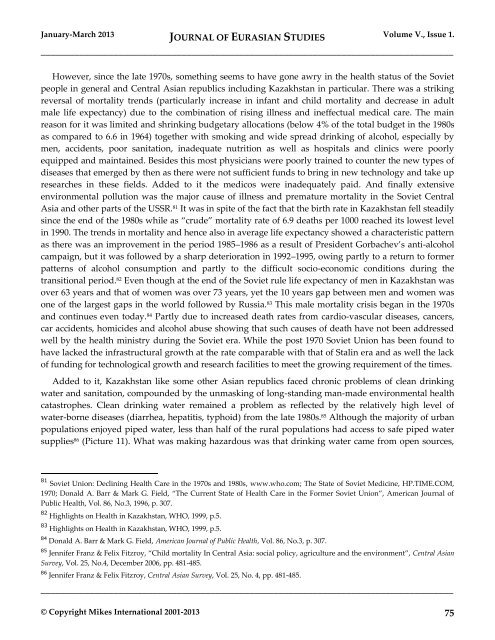JOURNAL OF EURASIAN STUDIES Journal of the Gábor Bálint de ...
JOURNAL OF EURASIAN STUDIES Journal of the Gábor Bálint de ...
JOURNAL OF EURASIAN STUDIES Journal of the Gábor Bálint de ...
You also want an ePaper? Increase the reach of your titles
YUMPU automatically turns print PDFs into web optimized ePapers that Google loves.
January-March 2013 <strong>JOURNAL</strong> <strong>OF</strong> <strong>EURASIAN</strong> <strong>STUDIES</strong> Volume V., Issue 1.<br />
_____________________________________________________________________________________<br />
However, since <strong>the</strong> late 1970s, something seems to have gone awry in <strong>the</strong> health status <strong>of</strong> <strong>the</strong> Soviet<br />
people in general and Central Asian republics including Kazakhstan in particular. There was a striking<br />
reversal <strong>of</strong> mortality trends (particularly increase in infant and child mortality and <strong>de</strong>crease in adult<br />
male life expectancy) due to <strong>the</strong> combination <strong>of</strong> rising illness and ineffectual medical care. The main<br />
reason for it was limited and shrinking budgetary allocations (below 4% <strong>of</strong> <strong>the</strong> total budget in <strong>the</strong> 1980s<br />
as compared to 6.6 in 1964) toge<strong>the</strong>r with smoking and wi<strong>de</strong> spread drinking <strong>of</strong> alcohol, especially by<br />
men, acci<strong>de</strong>nts, poor sanitation, ina<strong>de</strong>quate nutrition as well as hospitals and clinics were poorly<br />
equipped and maintained. Besi<strong>de</strong>s this most physicians were poorly trained to counter <strong>the</strong> new types <strong>of</strong><br />
diseases that emerged by <strong>the</strong>n as <strong>the</strong>re were not sufficient funds to bring in new technology and take up<br />
researches in <strong>the</strong>se fields. Ad<strong>de</strong>d to it <strong>the</strong> medicos were ina<strong>de</strong>quately paid. And finally extensive<br />
environmental pollution was <strong>the</strong> major cause <strong>of</strong> illness and premature mortality in <strong>the</strong> Soviet Central<br />
Asia and o<strong>the</strong>r parts <strong>of</strong> <strong>the</strong> USSR. 81 It was in spite <strong>of</strong> <strong>the</strong> fact that <strong>the</strong> birth rate in Kazakhstan fell steadily<br />
since <strong>the</strong> end <strong>of</strong> <strong>the</strong> 1980s while as “cru<strong>de</strong>” mortality rate <strong>of</strong> 6.9 <strong>de</strong>aths per 1000 reached its lowest level<br />
in 1990. The trends in mortality and hence also in average life expectancy showed a characteristic pattern<br />
as <strong>the</strong>re was an improvement in <strong>the</strong> period 1985–1986 as a result <strong>of</strong> Presi<strong>de</strong>nt Gorbachev’s anti-alcohol<br />
campaign, but it was followed by a sharp <strong>de</strong>terioration in 1992–1995, owing partly to a return to former<br />
patterns <strong>of</strong> alcohol consumption and partly to <strong>the</strong> difficult socio-economic conditions during <strong>the</strong><br />
transitional period. 82 Even though at <strong>the</strong> end <strong>of</strong> <strong>the</strong> Soviet rule life expectancy <strong>of</strong> men in Kazakhstan was<br />
over 63 years and that <strong>of</strong> women was over 73 years, yet <strong>the</strong> 10 years gap between men and women was<br />
one <strong>of</strong> <strong>the</strong> largest gaps in <strong>the</strong> world followed by Russia. 83 This male mortality crisis began in <strong>the</strong> 1970s<br />
and continues even today. 84 Partly due to increased <strong>de</strong>ath rates from cardio-vascular diseases, cancers,<br />
car acci<strong>de</strong>nts, homici<strong>de</strong>s and alcohol abuse showing that such causes <strong>of</strong> <strong>de</strong>ath have not been addressed<br />
well by <strong>the</strong> health ministry during <strong>the</strong> Soviet era. While <strong>the</strong> post 1970 Soviet Union has been found to<br />
have lacked <strong>the</strong> infrastructural growth at <strong>the</strong> rate comparable with that <strong>of</strong> Stalin era and as well <strong>the</strong> lack<br />
<strong>of</strong> funding for technological growth and research facilities to meet <strong>the</strong> growing requirement <strong>of</strong> <strong>the</strong> times.<br />
Ad<strong>de</strong>d to it, Kazakhstan like some o<strong>the</strong>r Asian republics faced chronic problems <strong>of</strong> clean drinking<br />
water and sanitation, compoun<strong>de</strong>d by <strong>the</strong> unmasking <strong>of</strong> long-standing man-ma<strong>de</strong> environmental health<br />
catastrophes. Clean drinking water remained a problem as reflected by <strong>the</strong> relatively high level <strong>of</strong><br />
water-borne diseases (diarrhea, hepatitis, typhoid) from <strong>the</strong> late 1980s. 85 Although <strong>the</strong> majority <strong>of</strong> urban<br />
populations enjoyed piped water, less than half <strong>of</strong> <strong>the</strong> rural populations had access to safe piped water<br />
supplies 86 (Picture 11). What was making hazardous was that drinking water came from open sources,<br />
81 Soviet Union: Declining Health Care in <strong>the</strong> 1970s and 1980s, www.who.com; The State <strong>of</strong> Soviet Medicine, HP.TIME.COM,<br />
1970; Donald A. Barr & Mark G. Field, “The Current State <strong>of</strong> Health Care in <strong>the</strong> Former Soviet Union”, American <strong>Journal</strong> <strong>of</strong><br />
Public Health, Vol. 86, No.3, 1996, p. 307.<br />
82 Highlights on Health in Kazakhstan, WHO, 1999, p.5.<br />
83 Highlights on Health in Kazakhstan, WHO, 1999, p.5.<br />
84 Donald A. Barr & Mark G. Field, American <strong>Journal</strong> <strong>of</strong> Public Health, Vol. 86, No.3, p. 307.<br />
85 Jennifer Franz & Felix Fitzroy, “Child mortality In Central Asia: social policy, agriculture and <strong>the</strong> environment”, Central Asian<br />
Survey, Vol. 25, No.4, December 2006, pp. 481-485.<br />
86 Jennifer Franz & Felix Fitzroy, Central Asian Survey, Vol. 25, No. 4, pp. 481-485.<br />
_____________________________________________________________________________________<br />
© Copyright Mikes International 2001-2013 75

















